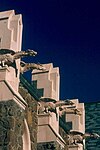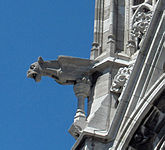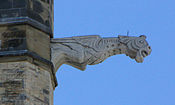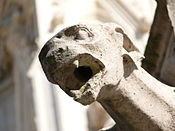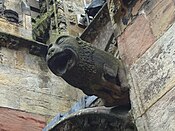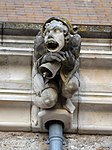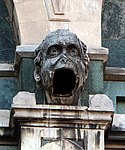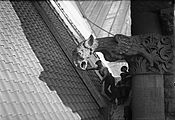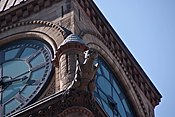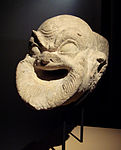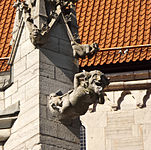Gargoyle: Difference between revisions
Reverted and/or undid 1 good faith edit by 74.79.151.105 using STiki - Mistake? - Tell Me Here |
Reverting edit(s) by 73.42.40.155 (talk) to rev. 1228371756 by Citation bot: Non-constructive edit (UV 0.1.5) |
||
| (455 intermediate revisions by more than 100 users not shown) | |||
| Line 1: | Line 1: | ||
{{short description|Exterior building sculpture}} |
|||
{{ref improve|date=December 2012}} |
|||
{{ |
{{about|the statues on buildings|the monster|Gargoyle (monster)|other uses|Gargoyle (disambiguation)}} |
||
[[File:Notre-Dame Rzygacze.JPG|thumb|Gargoyles of Notre-Dame de Paris]] |
[[File:Notre-Dame Rzygacze.JPG|thumb|Gargoyles of [[Notre-Dame de Paris]]]] |
||
[[File:Ayuntamiento, Tallin, Estonia, 2012-08-05, DD 05.JPG|thumb|Dragon-headed gargoyle of the [[Tallinn Town Hall]], [[Estonia]]]] |
[[File:Ayuntamiento, Tallin, Estonia, 2012-08-05, DD 05.JPG|thumb|Dragon-headed gargoyle of the [[Tallinn Town Hall]], [[Estonia]]]] |
||
[[File:Gargoyle Wawel Cathedral 01 AB.jpg|thumb|Gargoyle of |
[[File:Gargoyle Wawel Cathedral 01 AB.jpg|thumb|Gargoyle of the Vasa Chapel at [[Wawel]] in [[Kraków]], [[Poland]]]] |
||
In [[architecture]], a '''gargoyle''' is a carved stone [[Grotesque#In_architecture|grotesque]],<ref>{{Cite book|author=Janetta Rebold Benton|authorlink=|title=Holy Terrors: Gargoyles on Medieval Buildings|edition=|publisher=Abbeville Press|year=1997|location=New York|pages=6–8|url=|isbn=0-7892-0182-8}}</ref> with a spout designed to convey water from a roof and away from the side of a building thereby preventing rainwater from running down [[masonry]] walls and eroding the [[Mortar (masonry)|mortar]] between. Architects often used multiple gargoyles on buildings to divide the flow of rainwater off the roof to minimize the potential damage from a rainstorm. A trough is cut in the back of the gargoyle and rainwater typically exits through the open mouth. Gargoyles are usually an elongated fantastic animal because the length of the gargoyle determines how far water is thrown from the wall. When [[Gothic art|Gothic]] [[flying buttress]]es were used, [[aqueduct (watercourse)|aqueducts]] were sometimes cut into the buttress to divert water over the aisle walls. |
|||
In [[architecture]], and specifically [[Gothic architecture]], a '''gargoyle''' ({{IPAc-en|ˈ|ɡ|ɑr|ɡ|ɔɪ|l}}) is a carved or formed [[Grotesque (architecture)|grotesque]]<ref name="Benton 1997" />{{rp|6–8}} with a spout designed to convey water from a roof and away from the side of a building, thereby preventing it from running down [[masonry]] walls and eroding the [[Mortar (masonry)|mortar]] between. Architects often used multiple gargoyles on a building to divide the flow of rainwater off the roof to minimize potential damage from rainstorms. A trough is cut in the back of the gargoyle and rainwater typically exits through the open mouth. Gargoyles are usually elongated fantastical animals because their length determines how far water is directed from the wall. When [[Gothic art|Gothic]] [[flying buttress]]es were used, [[aqueduct (watercourse)|aqueducts]] were sometimes cut into the buttress to divert water over the aisle walls.<ref name="Wonderopolis">{{cite web |title=What Is a Gargoyle? |url=https://wonderopolis.org/wonder/what-is-a-gargoyle |website=Wonderopolis |access-date=19 October 2018 |language=en}}</ref> |
|||
==Etymology== |
|||
The term originates from the [[French language|French]] ''gargouille,'' which in English is likely to mean "throat" or is otherwise known as the "gullet";<ref name="AHD">{{Cite book|author=Houghton Mifflin|authorlink=Houghton Mifflin|title=The American Heritage Dictionary of the English Language|edition=4th|publisher=Houghton Mifflin|year=2000|location=Boston and New York|pages=725|url=http://www.houghtonmifflinbooks.com/epub/ahd4.shtml|isbn=978-0-395-82517-4}}</ref> cf. [[Latin]] ''gurgulio, gula, gargula ("gullet" or "throat")'' and similar words derived from the root ''gar,'' "to swallow", which represented the gurgling sound of water (e.g., Portuguese ''garganta,'' "throat"; ''gárgola,'' "gargoyle"). It is also connected to the French verb ''gargariser,'' which means "to gargle."<ref>{{Cite book|author=Janetta Rebold Benton|authorlink=|title=Holy Terrors: Gargoyles on Medieval Buildings|edition=|publisher=Abbeville Press|year=1997|location=New York|pages=8|url=|isbn=0-7892-0182-8}}</ref> The [[Italian language|Italian]] word for gargoyle is ''doccione'' or ''gronda sporgente,'' an architecturally precise phrase which means "protruding gutter." |
|||
== Etymology == |
|||
When not constructed as a waterspout and only serving an ornamental or artistic function, the correct term for such a sculpture is a [[Chimera (architecture)|chimera]]. Just as chimeras, gargoyles are said to frighten off and protect those that it guards, such as a church, from any evil or harmful spirits. |
|||
The term originates from the [[French language|French]] ''gargouille,'' which in English is likely to mean "throat" or is otherwise known as the "gullet";<ref name="Hargreaves 1990 p. 51" /><ref name="American Heritage Dictionary" /> cf. [[Latin]] ''gurgulio, gula, gargula'' ("gullet"or "throat") and similar words derived from the root ''gar,'' "to swallow", which represented the gurgling sound of water (e.g., [[Portuguese language|Portuguese]] and [[Spanish language|Spanish]] ''garganta,'' "throat"; ''gárgola,'' "gargoyle"). It is also connected to the French verb ''gargariser,'' which shares a Latin root with the verb "gargle"<ref name="Benton 1997" />{{rp|8}}<ref name="Online Etymology Dictionary" /> and is likely imitative in origin.<ref name="Merriam-Webster 2015" /> The [[Italian language|Italian]] word for gargoyle is ''doccione'' or ''gronda sporgente,'' an architecturally precise phrase which means "protruding gutter". Italian also uses ''gargolla'' or ''garguglia'', when it has a grotesque shape. |
|||
When not constructed as a waterspout and only serving an ornamental or artistic function, the technical term for such a sculpture is a [[Grotesque (architecture)|grotesque]], chimera, or [[Boss (architecture)|boss]]. There are also regional variations, such as the [[hunky punk]]. Just as with bosses and chimeras, gargoyles are said to protect what they guard, such as a church, from any evil or harmful spirits. |
|||
==Legend of La Gargouille== |
|||
A French legend that sprang up around the name of [[Romanus of Rouen|St. Romanus]] ("Romain") (AD 631–641), the former chancellor of the [[Merovingian dynasty|Merovingian]] king [[Clotaire II]] who was made [[bishop of Rouen]], relates how he delivered the country around [[Rouen]] from a monster called ''[[Gargouille]]'' or ''Goji''. La Gargouille is said to have been the typical dragon with batlike wings, a long neck, and the ability to breathe fire from its mouth. There are multiple versions of the story, either that St. Romanus subdued the creature with a crucifix, or he captured the creature with the help of the only volunteer, a condemned man. In each, the monster is led back to [[Rouen]] and burned, but its head and neck would not burn due to being tempered by its own fire breath. The head was then mounted on the walls of the newly built church to scare off evil spirits, and used for protection.<ref name="CIPA">{{cite book |
|||
== Legend of the Gargouille == |
|||
|last=Cipa |
|||
{{main|Gargoyle (monster)}} |
|||
|first=Shawn |
|||
A French legend that sprang up around the name of [[Romanus of Rouen|St. Romanus]] ({{lang-fr|Romain}}; [[floruit|fl.]] {{Circa|631–641 AD}}), the former chancellor of the [[Merovingian dynasty|Merovingian]] king [[Chlothar II]] who was made [[bishop of Rouen]], relates how he delivered the country around Rouen from a monster called ''Gargouille'' or ''Goji''.<ref name="Butler Thurston Attwater 1956 p. 183" /><ref name="Herbermann Pace Pallen Shahan 1913 p. 209" /> La Gargouille is said to have been the typical dragon with bat-like wings, a long neck, and the ability to breathe fire from its mouth. Multiple versions of the story are given, either that St. Romanus subdued the creature with a crucifix, or he captured the creature with the help of the only volunteer, a condemned man. In each, the monster is led back to Rouen and burned, but its head and neck would not burn due to being tempered by its own fire breath. The head was then mounted on the walls of the newly built church to scare off evil spirits, and used for protection.<ref name="Cipa 2009" /> In commemoration of St. Romain, the Archbishops of Rouen were granted the right to set a prisoner free on the day that the [[reliquary]] of the saint was carried in procession (see details at [[Rouen]]).<ref name="Hodder 1881 p. 46" /><ref name="British Archaeological Association 1939 p. 361" /> |
|||
|title=Carving Gargoyles, Grotesques, and Other Creatures of Myth: History, Lore, and 12 Artistic Patterns |
|||
|publisher= Fox Chapel Publishing Inc. |
|||
|year=2008 |
|||
|location=Petersburg, PA |
|||
|isbn=978-1565233294}}</ref> In commemoration of St. Romain, the Archbishops of Rouen were granted the right to set a prisoner free on the day that the [[reliquary]] of the saint was carried in procession (see details at [[Rouen]]). |
|||
== History == |
== History == |
||
The term ''gargoyle'' is most often applied to [[medieval]] work, but throughout all ages, some means of water diversion, when not conveyed in gutters, was adopted.{{sfn|Chisholm|1911}} In [[ancient Egypt]]ian architecture, gargoyles showed little variation, typically in the form of a lion's head.<ref name="Clarke Engelbach 1930" /> Similar lion-mouthed water spouts were also seen on [[Greek temple]]s, carved or modelled in the [[marble sculpture|marble]] or [[terracotta]] [[cymatium]] of the [[cornice (architecture)|cornice]].<ref name="Dinsmoor Anderson 1950" /> An excellent example of this are the 39 remaining lion-headed water spouts on the [[Temple of Zeus, Olympia|Temple of Zeus]].{{clarify|date=April 2021|reason=The Temple of Zeus is a pile of rubble. It has no remaining water spouts on it. Explain.}} Originally, it had 102 gargoyles or spouts, but due to the heavy weight (they were crafted from marble), many snapped off and had to be replaced.<ref name="Willemsen 1959" /><ref name="Swaddling 1980" /> |
|||
[[File:GorgoyleSharp.jpg|thumb|right|A 1st century BC Hellenistic gargoyle representing a comical cook-slave from [[Ai Khanoum]], [[Afghanistan]]]] |
|||
The term ''gargoyle'' is most often applied to [[medieval]] work, but throughout all ages some means of water diversion, when not conveyed in gutters, was adopted. In [[Ancient Egypt]]ian architecture, gargoyles showed little variation, typically in the form of a lion's head.<ref>{{cite book |
|||
|last1=Clarke |
|||
|first1=Somers |
|||
|last2=Engelbach |
|||
|first2=Reginald |
|||
|title=Ancient Egyptian Masonry: The Building Craft |
|||
|publisher=The Book Tree |
|||
|year=1930 |
|||
|isbn=1-58509-059-X}}</ref> Similar lion-mouthed water spouts were also seen on [[Greek temple]]s, carved or modeled in the [[marble sculpture|marble]] or [[terracotta]] [[cymatium]] of the [[cornice (architecture)|cornice]].<ref>{{cite book |
|||
|last=Dinsmoor |
|||
|first=William Bell |
|||
|title=The Architecture of Ancient Greece: an account of its historic development |
|||
|publisher=Biblo and Tannen |
|||
|year=1973 |
|||
|location=New York |
|||
|isbn=0819602833 |
|||
|isbn=978-0819602831}}</ref> An excellent example of this are the 39 remaining lion-headed water spouts on the [[Temple of Zeus]]. There were originally 102 gargoyles or spouts, but due to the heavy weight (they were crafted from marble), many have snapped off and had to be replaced.<ref>{{cite book |
|||
|last=Swaddling |
|||
|first=Judith |
|||
|title=The Ancient Olympic Games |
|||
|publisher=British Museum Press |
|||
|year=1989 |
|||
|isbn=0-292-77751-5}}</ref> |
|||
Many medieval cathedrals included gargoyles and chimeras. |
Many medieval cathedrals included gargoyles and chimeras.<ref name="Fudgé 2016 p. 91" /> According to French architect and author [[Eugène Viollet-le-Duc]], himself one of the great producers of gargoyles in the 19th century,<ref name="Hourihane 2012 p. 642" /> the earliest known medieval gargoyles appear on [[Laon Cathedral]] (c. 1200–1220).<ref name="Weinstock 2016 p. 248" /> One of the more famous examples is the gargoyles of [[Notre-Dame de Paris]]. Although most have grotesque features, the term gargoyle has come to include all types of images. Some gargoyles were depicted as monks, or combinations of real animals and people, many of which were humorous. Unusual animal mixtures, or chimeras, did not act as rainspouts and are more properly called grotesques. They serve as ornamentation but are now popularly called gargoyles. |
||
Both ornamented and unornamented |
Both ornamented and unornamented waterspouts projecting from roofs at parapet level were a common device used to shed rainwater from buildings until the early 18th century. From that time, more and more buildings used drainpipes to carry the water from the [[Rain gutter|guttering]] roof to the ground and only very few buildings using gargoyles were constructed. This was because some people found them frightening, and sometimes heavy ones fell off, causing damage. In 1724, the London Building Act passed by the [[Parliament of Great Britain]] made the use of downpipes compulsory in all new construction.<ref name="Holy Horrors" /> |
||
== |
== Catholic Church == |
||
There are divided ideas as to the purpose of adding gargoyles to religious structures. Some state that gargoyles were meant to illustrate [[evil]] and sin, while others have posited that grotesques in architecture were [[Apotropaic magic|apotropaic]] devices.<ref name="Tschen-Emmons 2015 p. 72" /> In the 12th century, before the use of gargoyles as rain spouts, [[Bernard of Clairvaux|St. Bernard of Clairvaux]] was famous for speaking out against gargoyles carved on the walls of his monastery's cloister:<ref name="Di Renzo 1995 p. 1" /> |
|||
[[File:Visby katedral.S.vattenkastare.jpg|thumb|right|Gargoyle representing a comical demon at the base of a [[pinnacle]] with two smaller gargoyles, [[Visby]], [[Sweden]]]] |
|||
Gargoyles were viewed in two ways by the church throughout history. The primary use was to convey the concept of [[evil]] through the form of the gargoyle, which was especially useful in sending a stark message to the common people, most of whom were [[Literacy|illiterate]]. Gargoyles also are said to scare evil spirits away from the church, this reassured congregants that evil was kept outside of the church’s walls.<ref>{{Cite book|last=Camille|first=Michael|title=The Gargoyles of Notre-Dame: Medievalism and the Monsters of Modernity |
|||
|publisher= University of Chicago Press|year=2009|location= Chicago, IL|isbn=0-226-09245-3}}</ref> However, some medieval clergy viewed gargoyles as a form of [[idolatry]]. In the 12th century [[Bernard of Clairvaux|St. Bernard of Clairvaux]] was famous for speaking out against gargoyles: |
|||
{{quotation|What are these fantastic monsters doing in the cloisters before the eyes of the brothers as they read? What is the meaning of these unclean monkeys, these strange savage lions |
{{quotation|What are these fantastic monsters doing in the cloisters before the eyes of the brothers as they read? What is the meaning of these unclean monkeys, these strange, savage lions and monsters? To what purpose are here placed these creatures, half beast, half man or these spotted tigers? I see several bodies with one head and several heads with one body. Here is a quadruped with a serpent's head; there a fish with a quadruped's head; then again an animal: half horse, half goat... Surely, if we do not blush for such absurdities, we should at least regret what we have spent on them.<ref name="Leclercq 1963" /><ref name="Nathan 1961 p. 74" /> |
||
{{cite book |
|||
|title=Tractatus et Opuscula |
|||
|last=St Bernard of Clairvaux (1090-1153) |
|||
|publisher=Rome, Editiones cistercienses |
|||
|editor-last=Leclercq |
|||
|editor-first=Jean |
|||
|editor2-last=Rochais |
|||
|editor2-first=H.M. |
|||
|volume=3 |
|||
|chapter=Apologia ad Guillelmum abbatem |
|||
|series=S. Bernardi Opera |
|||
|date=1963 |
|||
}}</ref> |
|||
}} |
}} |
||
According to Lester Burbank Bridaham, writing in '' |
According to Lester Burbank Bridaham, writing in ''Gargoyles, Chimeres and the Grotesque in French Gothic Sculpture'', "There is much symbolism in the sculpture of the Gothic period; but we must be wary of reading in too much meaning."<ref name="Bridaham 1930 p. xii" />{{Clear}} |
||
{{Clear left}} |
|||
==Animal |
== Animal == |
||
The [[ancient Egypt]]ians, [[Ancient Greece|Greeks]], [[Etruscan civilization|Etruscans]], and [[Ancient Rome|Romans]] all used animal-shaped waterspouts.<ref name="Benton 1997" />{{rp|11}} During the 12th Century, when gargoyles appeared in Europe, the Roman Catholic Church was growing stronger and converting many new people. Most of the population at this time was illiterate, so images were very important to convey ideas. Many early gargoyles depicted some version of a dragon, especially in France. In addition to serving as spouts for water, the gaping mouths of these gargoyles evoked the fearsome destructiveness of these legendary beasts, reminding the laity of the need for the church's protection.<ref name="Varner 2008" /> |
|||
[[File:Cathédrale de Meaux Transept Sud 140708 6.jpg|thumb| Gargoyle in form of a lion<br/> [[Meaux Cathedral|Cathedral Saint-Etienne de Meaux]]]] |
|||
The [[ancient Egypt]]ians, [[Ancient Greece|Greeks]], [[Etruscan civilization|Etruscans]] and [[Ancient Rome|Romans]] all used animal-shaped waterspouts.<ref name="Janetta Rebold Benton 1997 11">{{Cite book|author=Janetta Rebold Benton|authorlink=|title=Holy Terrors: Gargoyles on Medieval Buildings|edition=|publisher=Abbeville Press|year=1997|location=New York|pages=11|url=|isbn=0-7892-0182-8}}</ref> During the 12th century, when gargoyles appeared in Europe, the Roman Catholic Church was growing stronger and converting many new people. Most of the population at this time were illiterate, and therefore images were very important to convey ideas. In the medieval world many creatures had mystical powers attributed to them. Also, human qualities were sometimes ascribed to specific animals—that is, the animals were [[Anthropomorphism|anthropomorphized]]. This was especially common for pagans, and using these ideas helped conversion to Catholicism. Some animals (such as the [[rhinoceros]] and the [[hippopotamus]]) were unknown in western Europe during the Middle Ages so gargoyles of these species (such as the ones at [[Laon Cathedral]]) are modern gargoyles and therefore did not have symbolic meaning in Medieval times.<ref>{{Cite book|author=Janetta Rebold Benton|authorlink=|title=Holy Terrors: Gargoyles on Medieval Buildings|edition=|publisher=Abbeville Press|year=1997|location=New York|pages=20|url=|isbn=0-7892-0182-8}}</ref> |
|||
Human qualities were sometimes ascribed to specific animals—that is, the animals were [[Anthropomorphism|anthropomorphized]]. This was especially common for pagans, and using these ideas helped conversion to Catholicism. Some animals (such as the [[rhinoceros]] and the [[hippopotamus]]) were unknown in western Europe during the Middle Ages, so gargoyles of these species (such as the ones at [[Laon Cathedral]]) are modern gargoyles and therefore did not have symbolic meaning in Medieval times.<ref name="Benton 1997" />{{rp|20}} |
|||
==Gallery== |
|||
<center><gallery widths="175px" heights="150px"> |
|||
== Gallery == |
|||
Image:Gargoyles-StPartickFlagstaf.jpg|Chimera of Nativity of the Blessed Virgin Mary Chapel in [[Flagstaff, Arizona|Flagstaff]], [[Arizona]] |
|||
<gallery class="center" widths="175" heights="150" classes="center"> |
|||
Image:Gargoyle Sacre Coeur.jpg|A gargoyle on the [[Basilica of the Sacré Cœur]], Paris, France, showing the water channel |
|||
File:Gargoyles, Blessed Virgin Mary Chapel (Flagstaff, AZ).jpg|Chimera of Nativity of the Blessed Virgin Mary Chapel in [[Flagstaff, Arizona|Flagstaff]], [[Arizona]] |
|||
Image:Mausoleum(05).jpg|Gargoyle at the [[Sint-Petrus-en-Pauluskerk|St.-Petrus-en-Pauluskerk]], [[Ostend]], [[Belgium]] |
|||
File:Gargoyle Sacre Coeur.jpg|A gargoyle on the [[Sacré-Cœur, Paris|Basilique du Sacré-Cœur]], Paris, France, showing the water channel |
|||
Image:Dragon grotesque on Peace Tower.jpg|One of four gargoyles atop the [[Peace Tower]], [[Ottawa]], [[Ontario]], [[Canada]] |
|||
File:Iglesia de San Juan, Helsinki, Finlandia, 2012-08-14, DD 09.JPG|Gargoyle at the [[St. John's Church, Helsinki|St. John's Church]], [[Helsinki]], [[Finland]] |
|||
Image:ND Amiens - gargouille.JPG|Gargoyle [[Notre-Dame d'Amiens]], France |
|||
File:Mausoleum(05).jpg|Gargoyle at the [[Sint-Petrus-en-Pauluskerk|St.-Petrus-en-Pauluskerk]], [[Ostend]], [[Belgium]] |
|||
Image:GargoylesNotreDame-Dijon.jpg|Notre Dame Church in [[Dijon]], France |
|||
File:Dragon grotesque on Peace Tower.jpg|One of four gargoyles atop the [[Peace Tower]], [[Ottawa]], [[Ontario]], Canada |
|||
Image:Lakenhalle-dakgoot met waterspuwer.JPG|Gargoyle at the [[Cloth Hall, Ypres]], [[Belgium]] |
|||
File: |
File:ND Amiens - gargouille.JPG|Gargoyle of [[Notre-Dame d'Amiens]], France |
||
File:GargoylesNotreDame-Dijon.jpg|[[Church of Notre-Dame of Dijon|Notre Dame Church]] in [[Dijon]], France |
|||
File:Lakenhalle-dakgoot met waterspuwer.JPG|Gargoyle at the [[Cloth Hall, Ypres]], [[Belgium]] |
|||
File:Gargoyle on Zagreb Cathedral.jpg|Gargoyle on [[Zagreb Cathedral]], [[Croatia]] |
|||
File:Dombauhütte am Kölner Dom - Figur im Innenhof.jpg|Gargoyle from [[Cologne Cathedral]] under reconstruction |
File:Dombauhütte am Kölner Dom - Figur im Innenhof.jpg|Gargoyle from [[Cologne Cathedral]] under reconstruction |
||
File:Roger Morigi gargoyle, National Cathedral, Washington DC, USA.jpg|Gargoyle showing carver Roger Morigi with carver's tools, [[Washington National Cathedral]], [[Washington D.C.]], USA |
File:Roger Morigi gargoyle, National Cathedral, Washington DC, USA.jpg|Gargoyle showing carver Roger Morigi with carver's tools, [[Washington National Cathedral]], [[Washington D.C.]], USA |
||
File:Rosslyn Chapel Gargoyle.JPG|Gargoyle from [[Rosslyn Chapel]], [[Roslin, Midlothian|Roslin]], [[Scotland]]. |
File:Rosslyn Chapel Gargoyle.JPG|Gargoyle from [[Rosslyn Chapel]], [[Roslin, Midlothian|Roslin]], [[Scotland]]. |
||
File:Blain - Château de Blain (gargouille 4).jpg|Gargoyle from the [[Château de Blain]], [[France]] |
File:Blain - Château de Blain (gargouille 4).jpg|Gargoyle from the [[Château de Blain]], [[France]] |
||
File:Duomo di firenze, fianchi, doccione 03.JPG|Gargoyle from [[Santa Maria del Fiore]], [[Florence]], [[Italy]] (sometimes called "il Boccalone") |
|||
File:Paisley Abbey gargoyle 13.jpg|[[Paisley Abbey]] gargoyle |
|||
File:Old City Hall Gargoyle.jpg|Original Old City Hall, Toronto gargoyle |
File:Old City Hall Gargoyle.jpg|Original Old City Hall, Toronto gargoyle |
||
File:Gargoyle peering down on Queen Street.jpg|Replica gargoyles at Old City Hall, Toronto |
File:Gargoyle peering down on Queen Street.jpg|Replica gargoyles at Old City Hall, Toronto |
||
File:GorgoyleSharp.jpg|A 1st century BC Hellenistic gargoyle representing a comical cook-slave from [[Ai Khanoum]], [[Afghanistan]] |
|||
</gallery></center> |
|||
File:Paisley Abbey gargoyle 10.jpg|During a refurbishment of [[Paisley Abbey]] in the early 1990s, twelve gargoyles were replaced. One of them is modeled on [[Alien (creature in Alien franchise)|the titular creature]] from the 1979 film ''[[Alien (film)|Alien]]''. |
|||
File:Prčice,_kašna,_chrlič.jpg|Gargoyle spewing water as part of a fountain [[Prčice]], [[Sedlec-Prčice]], Příbram District, Central Bohemian Region, the Czech Republic. Vítek's Square |
|||
File:Visby katedral.S.vattenkastare.jpg|Gargoyle representing a comical demon at the base of a [[pinnacle]] with two smaller gargoyles, [[Visby]], Sweden |
|||
</gallery> |
|||
==See also== |
== See also == |
||
* [[Architectural sculpture]] |
* [[Architectural sculpture]] |
||
* [[ |
* [[Chiwen]] |
||
* {{Annotated link|Nightmares in the Sky|''Nightmares in the Sky''}} |
|||
* [[Golem]] |
|||
* [[Grotesque#In architecture|Grotesque in architecture]] |
|||
* [[Hunky Punk]] |
|||
* [[Onigawara]] |
|||
* [[Rainhead]] |
* [[Rainhead]] |
||
* [[ |
* [[Sheela na gig]] |
||
* [[Sheela na Gig]] |
|||
==References== |
== References == |
||
{{reflist|refs= |
|||
;Notes |
|||
<ref name="American Heritage Dictionary">{{Cite book |author = Houghton Mifflin |
|||
{{Reflist|colwidth=30em}} |
|||
|author-link = Houghton Mifflin |
|||
|title = The American Heritage Dictionary of the English Language |
|||
|edition = 4th |
|||
|publisher = Houghton Mifflin |
|||
|year = 2000 |
|||
|location = Boston and New York |
|||
|pages = [https://archive.org/details/americanheritage0000unse_a1o7/page/725 725] |
|||
|url = https://archive.org/details/americanheritage0000unse_a1o7/page/725 |
|||
|isbn = 978-0-395-82517-4 |
|||
}}</ref> |
|||
<ref name="Benton 1997">{{cite book |
|||
| last = Benton |
|||
| first = Janetta Rebold |
|||
| title = Holy Terrors: Gargoyles on Medieval Buildings |
|||
| publisher = Abbeville Press |
|||
| year = 1997 |
|||
| isbn = 978-0-7892-0182-9 |
|||
| url = https://books.google.com/books?id=XlBjQgAACAAJ |
|||
}}</ref> |
|||
<ref name="Bridaham 1930 p. xii">{{cite book |
|||
| last = Bridaham |
|||
| first = L.B. |
|||
| title = Gargoyles, Chimères, and the Grotesque in French Gothic Sculpture |
|||
| publisher = Architectural Book Publishing Company, Incorporated |
|||
| year = 1930 |
|||
| url = https://books.google.com/books?id=yRcaAQAAMAAJ |
|||
| page = xii |
|||
}}</ref> |
|||
<ref name="British Archaeological Association 1939 p. 361">{{cite book |
|||
| author = British Archaeological Association |
|||
| title = The Archaeological Journal |
|||
| publisher = Royal Archaeological Institute. |
|||
| issue = v. 95 |
|||
| year = 1939 |
|||
| url = https://books.google.com/books?id=CTspAAAAYAAJ |
|||
| access-date = May 11, 2018 |
|||
| page = 361 |
|||
| quote = During the Merovingian period Rouen occupies a prominent place in the long struggle between Fredegonde and Brunhilda, which culminated in the brutal murder of Bishop Pretextatus in his own cathedral. To the seventh ... The former's legendary victory over the monster Gargouille led to the well-known privilege of the Chapter of releasing a condemned criminal every Ascension Day. Charlemagne ... |
|||
}}</ref> |
|||
<ref name="Butler Thurston Attwater 1956 p. 183">{{cite book |
|||
| last1 = Butler |
|||
| first1 = A. |
|||
| last2 = Thurston |
|||
| first2 = H. |
|||
| last3 = Attwater |
|||
| first3 = D. |
|||
| title = Lives of the Saints |
|||
| publisher = Kenedy |
|||
| issue = v. 4 |
|||
| date = 1956 |
|||
| url = https://books.google.com/books?id=sFDZAAAAMAAJ |
|||
| access-date = May 11, 2018 |
|||
| page = 183 |
|||
| quote = ST ROMANUS, Bishop of Rouen (c. a.d. 640) Not much that is certainly authentic is known of this bishop. ... The legend is that this privilege took its rise from St Romanus killing a great serpent, called Gargouille, with the assistance of a ... |
|||
}}</ref> |
|||
<ref name="Cipa 2009">{{cite book |
|||
| last = Cipa |
|||
| first = S. |
|||
| title = Carving Gargoyles Grotesques, and Other Creatures of Myth: History, Lore, and 12 Artistic Patterns |
|||
| publisher = Fox Chapel Publishing Company, Incorporated |
|||
| year = 2009 |
|||
| isbn = 978-1-56523-329-4 |
|||
| url = https://books.google.com/books?id=nRIvvgAACAAJ |
|||
}}</ref> |
|||
<ref name="Clarke Engelbach 1930">{{cite book |
|||
| last1 = Clarke |
|||
| first1 = S. |
|||
| last2 = Engelbach |
|||
| first2 = R. |
|||
| title = Ancient Egyptian Construction and Architecture |
|||
| publisher = [[Dover Publications]] |
|||
| series = Dover books on Egypt |
|||
| year = 1930 |
|||
| isbn = 978-0-486-26485-1 |
|||
| url = https://books.google.com/books?id=L0Uiat5EAaMC |
|||
}}</ref> |
|||
<ref name="Di Renzo 1995 p. 1">{{cite book |
|||
| last = Di Renzo |
|||
| first = A. |
|||
| title = American Gargoyles: Flannery O'Connor and the Medieval Grotesque |
|||
| publisher = Southern Illinois University Press |
|||
| year = 1995 |
|||
| isbn = 978-0-8093-2030-1 |
|||
| url = https://books.google.com/books?id=ES5eiv2VgzkC&pg=PA1 |
|||
| access-date = May 11, 2018 |
|||
| page = 1 |
|||
}}</ref> |
|||
<ref name="Dinsmoor Anderson 1950">{{cite book |
|||
| last1 = Dinsmoor |
|||
| first1 = W.B. |
|||
| last2 = Anderson |
|||
| first2 = W.J. |
|||
| title = The Architecture of Ancient Greece: An Account of Its Historic Development |
|||
| publisher = Biblo and Tannen |
|||
| year = 1950 |
|||
| isbn = 978-0-8196-0283-1 |
|||
| url = https://books.google.com/books?id=BqahvzeE39YC |
|||
}}</ref> |
|||
<ref name="Fudgé 2016 p. 91">{{cite book |
|||
| last = Fudgé |
|||
| first = T.A. |
|||
| title = Medieval Religion and its Anxieties: History and Mystery in the Other Middle Ages |
|||
| publisher = Palgrave Macmillan US |
|||
| series = The New Middle Ages |
|||
| year = 2016 |
|||
| isbn = 978-1-137-56610-2 |
|||
| url = https://books.google.com/books?id=KO5NDQAAQBAJ&pg=PA91 |
|||
| access-date = May 11, 2018 |
|||
| page = 91 |
|||
}}</ref> |
|||
<ref name="Hargreaves 1990 p. 51">{{cite book |
|||
| last = Hargreaves |
|||
| first = J. |
|||
| title = Hargreaves New Illustrated Bestiary |
|||
| publisher = Gothic Image Publications |
|||
| year = 1990 |
|||
| isbn = 978-0-906362-12-9 |
|||
| url = https://books.google.com/books?id=64vfAAAAMAAJ |
|||
| access-date = May 11, 2018 |
|||
| page = 51 |
|||
| quote = The word Gargoyle is derived from 'La Gargouille'—the name of an immense dragon who lived in the river Seine at Rouen. The word Gargouille comes from the word for a throat, and gargle is derived from the same source. La Gargouille was ... |
|||
}}</ref> |
|||
<ref name="Herbermann Pace Pallen Shahan 1913 p. 209">{{cite book |
|||
| last1 = Herbermann |
|||
| first1 = C.G. |
|||
| last2 = Pace |
|||
| first2 = E.A. |
|||
| last3 = Pallen |
|||
| first3 = C.B. |
|||
| last4 = Shahan |
|||
| first4 = T.J. |
|||
| last5 = Wynne |
|||
| first5 = J.J. |
|||
| last6 = MacErlean |
|||
| first6 = A.A. |
|||
| title = The Catholic Encyclopedia: An International Work of Reference on the Constitution, Doctrine, Discipline, and History of the Catholic Church |
|||
| publisher = Robert Appleton company |
|||
| issue = v. 13 |
|||
| year = 1913 |
|||
| url = https://books.google.com/books?id=4m0sAAAAIAAJ |
|||
| access-date = May 11, 2018 |
|||
| page = 209 |
|||
| quote = St. Romanus (631–641) former chancellor of Clotaire II; legend relates how he delivered the environs of Rouen from a monster called Gargouille, having ... |
|||
}}</ref> |
|||
<ref name="Hodder 1881 p. 46">{{cite book |
|||
| last = Hodder |
|||
| first = E. |
|||
| title = Cities of the world |
|||
| issue = v. 2 |
|||
| year = 1881 |
|||
| url = https://books.google.com/books?id=xC8BAAAAQAAJ |
|||
| access-date = May 11, 2018 |
|||
| page = 46 |
|||
| quote = The bishop put a leash round its neck, and the criminal led the Gargouille into Rouen, where, amidst the acclamations of the ... And so once a year, on Ascension Day, until the time of the Revolution, the chapter used to select a condemned ... |
|||
}}</ref> |
|||
<ref name="Holy Horrors">{{Cite journal |
|||
| title = Holy Horrors |
|||
| journal = The National Trust Magazine |
|||
| date = Autumn 2007 |
|||
| pages = 66–68 |
|||
}}</ref> |
|||
<ref name="Hourihane 2012 p. 642">{{cite book |
|||
| last = Hourihane |
|||
| first = C. |
|||
| title = The Grove Encyclopedia of Medieval Art and Architecture |
|||
| publisher = OUP USA |
|||
| issue = v. 1 |
|||
| year = 2012 |
|||
| isbn = 978-0-19-539536-5 |
|||
| url = https://books.google.com/books?id=FtlMAgAAQBAJ&pg=PA642 |
|||
| access-date = May 11, 2018 |
|||
| page = 642 |
|||
}}</ref> |
|||
<ref name="Leclercq 1963">{{cite book |
|||
| title = Tractatus et opuscula |
|||
| publisher = Editiones Cistercienses |
|||
| location = Rome |
|||
| editor-last = Leclercq |
|||
| editor-first = Jean |
|||
| editor2-last = Rochais |
|||
| editor2-first = H.M. |
|||
| volume = 3 |
|||
| chapter = Apologia ad Guillelmum abbatem |
|||
| series = S. Bernardi Opera |
|||
| year = 1963 |
|||
| chapter-url = https://books.google.com/books?id=mB7ZAAAAMAAJ&pg=PR10 |
|||
| language = la |
|||
}}</ref> |
|||
<ref name="Merriam-Webster 2015">{{cite web |
|||
| title = Word of the Day: Gargoyle |
|||
| website = Merriam-Webster |
|||
| date = September 5, 2015 |
|||
| url = https://www.merriam-webster.com/word-of-the-day/gargoyle-2015-09-05 |
|||
| archive-url = https://web.archive.org/web/20170624191852/https://www.merriam-webster.com/word-of-the-day/gargoyle-2015-09-05 |
|||
| archive-date = June 24, 2017 |
|||
| url-status = live |
|||
| access-date = May 11, 2018 |
|||
}}</ref> |
|||
<ref name="Nathan 1961 p. 74">{{cite book |
|||
| last = Nathan |
|||
| first = W.L. |
|||
| title = Art and the Message of the Church |
|||
| publisher = Westminster Press |
|||
| series = Westminster studies in Christian communication |
|||
| year = 1961 |
|||
| url = https://books.google.com/books?id=eMefAAAAMAAJ |
|||
| access-date = May 11, 2018 |
|||
| page = 74 |
|||
}}</ref> |
|||
<ref name="Online Etymology Dictionary">{{cite web |
|||
| title = gargle |
|||
| website = Origin and meaning of gargle by Online Etymology Dictionary |
|||
| url = https://www.etymonline.com/word/gargle |
|||
| access-date = May 11, 2018 |
|||
}}</ref> |
|||
<ref name="Swaddling 1980">{{cite book |
|||
| last = Swaddling |
|||
| first = J. |
|||
| title = The ancient Olympic Games |
|||
| publisher = Published for the trustees of the British Museum by British Museum Publications |
|||
| year = 1980 |
|||
| isbn = 9780714120027 |
|||
| url = https://books.google.com/books?id=5tTfAAAAMAAJ |
|||
}}</ref> |
|||
<ref name="Tschen-Emmons 2015 p. 72">{{cite book |
|||
| last = Tschen-Emmons |
|||
| first = J.B. |
|||
| title = Artifacts from Medieval Europe |
|||
| publisher = ABC-CLIO |
|||
| series = Daily Life through Artifacts |
|||
| year = 2015 |
|||
| isbn = 978-1-61069-622-7 |
|||
| url = https://books.google.com/books?id=K78oBgAAQBAJ&pg=PA72 |
|||
| access-date = May 11, 2018 |
|||
| page = 72 |
|||
}}</ref> |
|||
<ref name="Varner 2008">{{cite book |
|||
| last = Varner |
|||
| first = G.R. |
|||
| title = Gargoyles, Grotesques & Green Men: Ancient Symbolism in European and American Architecture |
|||
| publisher = Lulu.com |
|||
| year = 2008 |
|||
| isbn = 978-1-4357-1142-6 |
|||
| url = https://books.google.com/books?id=VYQIOw8HU0sC |
|||
}}{{self-published source|date=February 2020}}</ref>{{self-published inline|date=February 2020}} |
|||
<ref name="Weinstock 2016 p. 248">{{cite book |
|||
| last = Weinstock |
|||
| first = J.A. |
|||
| title = The Ashgate Encyclopedia of Literary and Cinematic Monsters |
|||
| publisher = Taylor & Francis |
|||
| year = 2016 |
|||
| isbn = 978-1-317-04426-0 |
|||
| url = https://books.google.com/books?id=PHbeCwAAQBAJ&pg=PA248 |
|||
| access-date = May 11, 2018 |
|||
| page = 248 |
|||
}}</ref> |
|||
<ref name="Willemsen 1959">{{cite book |
|||
| last = Willemsen |
|||
| first = F. |
|||
| title = Die Löwenkopf-Wasserspeier Vom Dach des Zeustempels |
|||
| publisher = de Gruyter | location = Berlin |
|||
| series = Olympische Forschungen |
|||
| year = 1959 |
|||
| volume = 4 |
|||
| isbn = 978-3-11-003144-7 |
|||
| url = https://books.google.com/books?id=CZxvcgAACAAJ |
|||
| language = de |
|||
}}</ref> |
|||
}} |
|||
== Further reading == |
|||
* {{cite book |
|||
*''Guide to Gargoyles and Other Grotesques'' (2003) Wendy True Gasch, ISBN 0-9745299-0-7 |
|||
| last = Gasch |
|||
*''The Stone Carvers: Master Craftsmen of the Washington National Cathedral'' (1999) Marjorie Hunt, ISBN 1-56098-829-0 |
|||
| first = W.T. |
|||
*''Mailands Monster / Milan's Monsters. Wasserspeier und Grotesken in Mailand / Gargoyles and Grotesques in Milan'' (2010) Regina E.G. Schymiczek, ISBN 978-3-8391-8256-7. |
|||
| title = Guide to Gargoyles and Other Grotesques |
|||
| publisher = Washington National Cathedral |
|||
| year = 2003 |
|||
| isbn = 978-0-9745299-0-5 |
|||
| url = https://books.google.com/books?id=nQ9pAAAACAAJ |
|||
}} |
|||
* {{cite book |
|||
| last = Schymiczek |
|||
| first = R.E.G. |
|||
| title = Mailands Monster / Milan's Monsters |
|||
| publisher = Books on Demand |
|||
| year = 2011 |
|||
| isbn = 978-3-8391-9593-2 |
|||
| url = https://books.google.com/books?id=1csnAQAAQBAJ |
|||
}} |
|||
* {{cite book |
|||
| last = Hunt |
|||
| first = M. |
|||
| title = The Stone Carvers: Master Craftsmen of Washington National Cathedral |
|||
| publisher = Smithsonian Institution Press |
|||
| year = 1999 |
|||
| isbn = 978-1-56098-829-8 |
|||
| url = https://books.google.com/books?id=z8OVQgAACAAJ |
|||
}} |
|||
==External links== |
== External links == |
||
{{Commons category|Gargoyles}} |
{{Commons category|Gargoyles}} |
||
* [http://doloresherrero.com/?lang=en Gargoyles – Dolores Herrero] |
|||
{{Cite EB1911|wstitle=Gargoyle}} |
|||
* [http://www.normandythenandnow.com/the-legend-of-saint-romain-the-dragon-in-rouen/ Rouen in France claims to be the origin of gargoyles, through the legend of a dragon La Gargouille] |
|||
* [http://www.minervaconservation.com/articles/hunkypunks VIDEO about the conservation of Gargoyles] |
|||
* [https://web.archive.org/web/20010614025542/http://mondrian.princeton.edu/CampusWWW/Communications/Gargoyles.pdf The Gargoyles of Princeton University] |
|||
* {{Cite EB1911|wstitle=Gargoyle|volume=11|page=466}} |
|||
{{Authority control}} |
|||
[[Category:13th-century introductions]] |
|||
[[Category:Ornaments]] |
[[Category:Ornaments]] |
||
[[Category: |
[[Category:Drainage]] |
||
[[Category: |
[[Category:French folklore]] |
||
[[Category:Gothic architecture]] |
|||
[[Category:Grotesques]] |
|||
[[Category:Objects believed to protect from evil]] |
|||
[[Category:Outdoor sculptures]] |
|||
[[Category:Supernatural legends]] |
|||
Latest revision as of 22:56, 21 June 2024

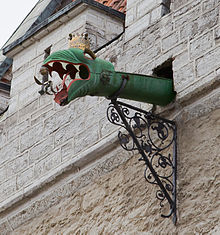

In architecture, and specifically Gothic architecture, a gargoyle (/ˈɡɑːrɡɔɪl/) is a carved or formed grotesque[1]: 6–8 with a spout designed to convey water from a roof and away from the side of a building, thereby preventing it from running down masonry walls and eroding the mortar between. Architects often used multiple gargoyles on a building to divide the flow of rainwater off the roof to minimize potential damage from rainstorms. A trough is cut in the back of the gargoyle and rainwater typically exits through the open mouth. Gargoyles are usually elongated fantastical animals because their length determines how far water is directed from the wall. When Gothic flying buttresses were used, aqueducts were sometimes cut into the buttress to divert water over the aisle walls.[2]
Etymology[edit]
The term originates from the French gargouille, which in English is likely to mean "throat" or is otherwise known as the "gullet";[3][4] cf. Latin gurgulio, gula, gargula ("gullet"or "throat") and similar words derived from the root gar, "to swallow", which represented the gurgling sound of water (e.g., Portuguese and Spanish garganta, "throat"; gárgola, "gargoyle"). It is also connected to the French verb gargariser, which shares a Latin root with the verb "gargle"[1]: 8 [5] and is likely imitative in origin.[6] The Italian word for gargoyle is doccione or gronda sporgente, an architecturally precise phrase which means "protruding gutter". Italian also uses gargolla or garguglia, when it has a grotesque shape.
When not constructed as a waterspout and only serving an ornamental or artistic function, the technical term for such a sculpture is a grotesque, chimera, or boss. There are also regional variations, such as the hunky punk. Just as with bosses and chimeras, gargoyles are said to protect what they guard, such as a church, from any evil or harmful spirits.
Legend of the Gargouille[edit]
A French legend that sprang up around the name of St. Romanus (French: Romain; fl. c. 631–641 AD), the former chancellor of the Merovingian king Chlothar II who was made bishop of Rouen, relates how he delivered the country around Rouen from a monster called Gargouille or Goji.[7][8] La Gargouille is said to have been the typical dragon with bat-like wings, a long neck, and the ability to breathe fire from its mouth. Multiple versions of the story are given, either that St. Romanus subdued the creature with a crucifix, or he captured the creature with the help of the only volunteer, a condemned man. In each, the monster is led back to Rouen and burned, but its head and neck would not burn due to being tempered by its own fire breath. The head was then mounted on the walls of the newly built church to scare off evil spirits, and used for protection.[9] In commemoration of St. Romain, the Archbishops of Rouen were granted the right to set a prisoner free on the day that the reliquary of the saint was carried in procession (see details at Rouen).[10][11]
History[edit]
The term gargoyle is most often applied to medieval work, but throughout all ages, some means of water diversion, when not conveyed in gutters, was adopted.[12] In ancient Egyptian architecture, gargoyles showed little variation, typically in the form of a lion's head.[13] Similar lion-mouthed water spouts were also seen on Greek temples, carved or modelled in the marble or terracotta cymatium of the cornice.[14] An excellent example of this are the 39 remaining lion-headed water spouts on the Temple of Zeus.[clarification needed] Originally, it had 102 gargoyles or spouts, but due to the heavy weight (they were crafted from marble), many snapped off and had to be replaced.[15][16]
Many medieval cathedrals included gargoyles and chimeras.[17] According to French architect and author Eugène Viollet-le-Duc, himself one of the great producers of gargoyles in the 19th century,[18] the earliest known medieval gargoyles appear on Laon Cathedral (c. 1200–1220).[19] One of the more famous examples is the gargoyles of Notre-Dame de Paris. Although most have grotesque features, the term gargoyle has come to include all types of images. Some gargoyles were depicted as monks, or combinations of real animals and people, many of which were humorous. Unusual animal mixtures, or chimeras, did not act as rainspouts and are more properly called grotesques. They serve as ornamentation but are now popularly called gargoyles.
Both ornamented and unornamented waterspouts projecting from roofs at parapet level were a common device used to shed rainwater from buildings until the early 18th century. From that time, more and more buildings used drainpipes to carry the water from the guttering roof to the ground and only very few buildings using gargoyles were constructed. This was because some people found them frightening, and sometimes heavy ones fell off, causing damage. In 1724, the London Building Act passed by the Parliament of Great Britain made the use of downpipes compulsory in all new construction.[20]
Catholic Church[edit]
There are divided ideas as to the purpose of adding gargoyles to religious structures. Some state that gargoyles were meant to illustrate evil and sin, while others have posited that grotesques in architecture were apotropaic devices.[21] In the 12th century, before the use of gargoyles as rain spouts, St. Bernard of Clairvaux was famous for speaking out against gargoyles carved on the walls of his monastery's cloister:[22]
What are these fantastic monsters doing in the cloisters before the eyes of the brothers as they read? What is the meaning of these unclean monkeys, these strange, savage lions and monsters? To what purpose are here placed these creatures, half beast, half man or these spotted tigers? I see several bodies with one head and several heads with one body. Here is a quadruped with a serpent's head; there a fish with a quadruped's head; then again an animal: half horse, half goat... Surely, if we do not blush for such absurdities, we should at least regret what we have spent on them.[23][24]
According to Lester Burbank Bridaham, writing in Gargoyles, Chimeres and the Grotesque in French Gothic Sculpture, "There is much symbolism in the sculpture of the Gothic period; but we must be wary of reading in too much meaning."[25]
Animal[edit]
The ancient Egyptians, Greeks, Etruscans, and Romans all used animal-shaped waterspouts.[1]: 11 During the 12th Century, when gargoyles appeared in Europe, the Roman Catholic Church was growing stronger and converting many new people. Most of the population at this time was illiterate, so images were very important to convey ideas. Many early gargoyles depicted some version of a dragon, especially in France. In addition to serving as spouts for water, the gaping mouths of these gargoyles evoked the fearsome destructiveness of these legendary beasts, reminding the laity of the need for the church's protection.[26]
Human qualities were sometimes ascribed to specific animals—that is, the animals were anthropomorphized. This was especially common for pagans, and using these ideas helped conversion to Catholicism. Some animals (such as the rhinoceros and the hippopotamus) were unknown in western Europe during the Middle Ages, so gargoyles of these species (such as the ones at Laon Cathedral) are modern gargoyles and therefore did not have symbolic meaning in Medieval times.[1]: 20
Gallery[edit]
-
A gargoyle on the Basilique du Sacré-Cœur, Paris, France, showing the water channel
-
Gargoyle of Notre-Dame d'Amiens, France
-
Notre Dame Church in Dijon, France
-
Gargoyle at the Cloth Hall, Ypres, Belgium
-
Gargoyle on Zagreb Cathedral, Croatia
-
Gargoyle from Cologne Cathedral under reconstruction
-
Gargoyle showing carver Roger Morigi with carver's tools, Washington National Cathedral, Washington D.C., USA
-
Gargoyle from the Château de Blain, France
-
Original Old City Hall, Toronto gargoyle
-
Replica gargoyles at Old City Hall, Toronto
-
A 1st century BC Hellenistic gargoyle representing a comical cook-slave from Ai Khanoum, Afghanistan
-
During a refurbishment of Paisley Abbey in the early 1990s, twelve gargoyles were replaced. One of them is modeled on the titular creature from the 1979 film Alien.
-
Gargoyle spewing water as part of a fountain Prčice, Sedlec-Prčice, Příbram District, Central Bohemian Region, the Czech Republic. Vítek's Square
See also[edit]
- Architectural sculpture
- Chiwen
- Nightmares in the Sky – Coffee table book by Stephen King and f-stop Fitzgerald
- Rainhead
- Sheela na gig
References[edit]
- ^ a b c d Benton, Janetta Rebold (1997). Holy Terrors: Gargoyles on Medieval Buildings. Abbeville Press. ISBN 978-0-7892-0182-9.
- ^ "What Is a Gargoyle?". Wonderopolis. Retrieved 19 October 2018.
- ^ Hargreaves, J. (1990). Hargreaves New Illustrated Bestiary. Gothic Image Publications. p. 51. ISBN 978-0-906362-12-9. Retrieved May 11, 2018.
The word Gargoyle is derived from 'La Gargouille'—the name of an immense dragon who lived in the river Seine at Rouen. The word Gargouille comes from the word for a throat, and gargle is derived from the same source. La Gargouille was ...
- ^ Houghton Mifflin (2000). The American Heritage Dictionary of the English Language (4th ed.). Boston and New York: Houghton Mifflin. pp. 725. ISBN 978-0-395-82517-4.
- ^ "gargle". Origin and meaning of gargle by Online Etymology Dictionary. Retrieved May 11, 2018.
- ^ "Word of the Day: Gargoyle". Merriam-Webster. September 5, 2015. Archived from the original on June 24, 2017. Retrieved May 11, 2018.
- ^ Butler, A.; Thurston, H.; Attwater, D. (1956). Lives of the Saints. Kenedy. p. 183. Retrieved May 11, 2018.
ST ROMANUS, Bishop of Rouen (c. a.d. 640) Not much that is certainly authentic is known of this bishop. ... The legend is that this privilege took its rise from St Romanus killing a great serpent, called Gargouille, with the assistance of a ...
- ^ Herbermann, C.G.; Pace, E.A.; Pallen, C.B.; Shahan, T.J.; Wynne, J.J.; MacErlean, A.A. (1913). The Catholic Encyclopedia: An International Work of Reference on the Constitution, Doctrine, Discipline, and History of the Catholic Church. Robert Appleton company. p. 209. Retrieved May 11, 2018.
St. Romanus (631–641) former chancellor of Clotaire II; legend relates how he delivered the environs of Rouen from a monster called Gargouille, having ...
- ^ Cipa, S. (2009). Carving Gargoyles Grotesques, and Other Creatures of Myth: History, Lore, and 12 Artistic Patterns. Fox Chapel Publishing Company, Incorporated. ISBN 978-1-56523-329-4.
- ^ Hodder, E. (1881). Cities of the world. p. 46. Retrieved May 11, 2018.
The bishop put a leash round its neck, and the criminal led the Gargouille into Rouen, where, amidst the acclamations of the ... And so once a year, on Ascension Day, until the time of the Revolution, the chapter used to select a condemned ...
- ^ British Archaeological Association (1939). The Archaeological Journal. Royal Archaeological Institute. p. 361. Retrieved May 11, 2018.
During the Merovingian period Rouen occupies a prominent place in the long struggle between Fredegonde and Brunhilda, which culminated in the brutal murder of Bishop Pretextatus in his own cathedral. To the seventh ... The former's legendary victory over the monster Gargouille led to the well-known privilege of the Chapter of releasing a condemned criminal every Ascension Day. Charlemagne ...
- ^ Chisholm 1911.
- ^ Clarke, S.; Engelbach, R. (1930). Ancient Egyptian Construction and Architecture. Dover books on Egypt. Dover Publications. ISBN 978-0-486-26485-1.
- ^ Dinsmoor, W.B.; Anderson, W.J. (1950). The Architecture of Ancient Greece: An Account of Its Historic Development. Biblo and Tannen. ISBN 978-0-8196-0283-1.
- ^ Willemsen, F. (1959). Die Löwenkopf-Wasserspeier Vom Dach des Zeustempels. Olympische Forschungen (in German). Vol. 4. Berlin: de Gruyter. ISBN 978-3-11-003144-7.
- ^ Swaddling, J. (1980). The ancient Olympic Games. Published for the trustees of the British Museum by British Museum Publications. ISBN 9780714120027.
- ^ Fudgé, T.A. (2016). Medieval Religion and its Anxieties: History and Mystery in the Other Middle Ages. The New Middle Ages. Palgrave Macmillan US. p. 91. ISBN 978-1-137-56610-2. Retrieved May 11, 2018.
- ^ Hourihane, C. (2012). The Grove Encyclopedia of Medieval Art and Architecture. OUP USA. p. 642. ISBN 978-0-19-539536-5. Retrieved May 11, 2018.
- ^ Weinstock, J.A. (2016). The Ashgate Encyclopedia of Literary and Cinematic Monsters. Taylor & Francis. p. 248. ISBN 978-1-317-04426-0. Retrieved May 11, 2018.
- ^ "Holy Horrors". The National Trust Magazine: 66–68. Autumn 2007.
- ^ Tschen-Emmons, J.B. (2015). Artifacts from Medieval Europe. Daily Life through Artifacts. ABC-CLIO. p. 72. ISBN 978-1-61069-622-7. Retrieved May 11, 2018.
- ^ Di Renzo, A. (1995). American Gargoyles: Flannery O'Connor and the Medieval Grotesque. Southern Illinois University Press. p. 1. ISBN 978-0-8093-2030-1. Retrieved May 11, 2018.
- ^ Leclercq, Jean; Rochais, H.M., eds. (1963). "Apologia ad Guillelmum abbatem". Tractatus et opuscula. S. Bernardi Opera (in Latin). Vol. 3. Rome: Editiones Cistercienses.
- ^ Nathan, W.L. (1961). Art and the Message of the Church. Westminster studies in Christian communication. Westminster Press. p. 74. Retrieved May 11, 2018.
- ^ Bridaham, L.B. (1930). Gargoyles, Chimères, and the Grotesque in French Gothic Sculpture. Architectural Book Publishing Company, Incorporated. p. xii.
- ^ Varner, G.R. (2008). Gargoyles, Grotesques & Green Men: Ancient Symbolism in European and American Architecture. Lulu.com. ISBN 978-1-4357-1142-6.[self-published source]
Further reading[edit]
- Gasch, W.T. (2003). Guide to Gargoyles and Other Grotesques. Washington National Cathedral. ISBN 978-0-9745299-0-5.
- Schymiczek, R.E.G. (2011). Mailands Monster / Milan's Monsters. Books on Demand. ISBN 978-3-8391-9593-2.
- Hunt, M. (1999). The Stone Carvers: Master Craftsmen of Washington National Cathedral. Smithsonian Institution Press. ISBN 978-1-56098-829-8.
External links[edit]
- Gargoyles – Dolores Herrero
- Rouen in France claims to be the origin of gargoyles, through the legend of a dragon La Gargouille
- VIDEO about the conservation of Gargoyles
- The Gargoyles of Princeton University
- Chisholm, Hugh, ed. (1911). . Encyclopædia Britannica. Vol. 11 (11th ed.). Cambridge University Press. p. 466.

